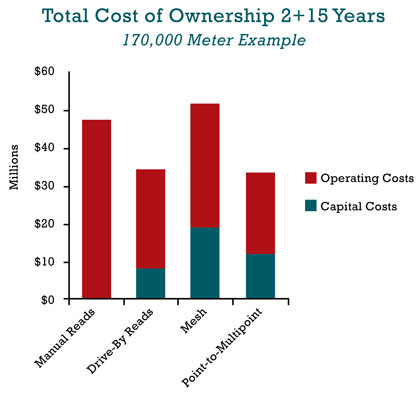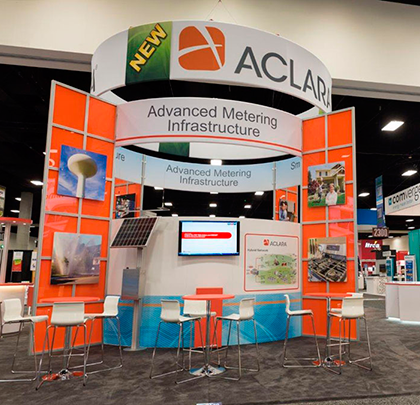Last month, we introduced the first part of the following report summarizing the findings of a recent study conducted by the Wired Group, which indicates that the choice of meter communication network is a critical decision when determining the TCO of a meter-reading network over time. The principle benefit illustrates how utilities can apply TCO evaluation, which takes into account on-going operations costs, replacement and lifecycle costs, and personnel, as well as initial capital investment, to get a more complete picture of what systems will actually cost over time. These TCO calculations prove that point-to-multipoint fixed-network solutions can provide the best TCO of any competitive system, including manual, drive-by, or mesh fixed network solutions.
THE EFFECT OF NETWORK SELECTION ON ONGOING COSTS
In its interviews with utilities during the course of validation, the Wired Group collected some additional information worth noting, which is outlined in the following sections.
The Wired Group found that one of the biggest differentiators between mesh and point-to-multipoint, according to utilities surveyed, is that mesh networks must recreate pathways to access points after an electric outage, during which time the meter is unavailable to the network. The process of recreating pathways can require a few hours to a few days to complete once electric service is restored. In point-to-multipoint networks, because each meter communicates directly to data collectors that then communicate to the utility, there are no paths to create or configure.
Why does this matter? The biggest impact of this on utility costs and operations involves service orders, such as disconnects for non-payment and reconnects, which must be carried out manually (via a truck roll) for meters that are temporarily unreachable. The effects of this can be seen in service order completion rates, which are generally lower for utilities using mesh networks.
In addition, manual reconfigurations and/or field device adjustments occasionally must be made to reconnect some meters to access points after pathways are automatically reconnected after outages. While manual service orders and network adjustments are few in percentage terms, they are significant in number and costs. For example, a 4 percent reduction in automated service order completions for a utility with 500,000 service orders annually equates to 20,000 manual service orders; most utilities assume a cost between $35 and $50 for each manually-completed service order, or $700,000 to $1,000,000 a year.
Some utilities report that meter pathways purposely established by network engineers—for example, to balance access point data loading—must automatically re-establish after an outage. In some cases, meters default back to their original path instead of the revised path network engineers intentionally established. The effects of these issues can be seen in the size of network management staff, which is generally larger for utilities using mesh networks.
Finally, the Wired Group investigated the qualifications of personnel used to maintain or make adjustments to field network devices. The working hypothesis was that mesh networks required more specialized personnel than other types of networks. The Wired Group did not find this to be the case.
Instead, the physical location of field network devices appeared to drive personnel qualifications regardless of meter communications network type. Maintenance on or adjustments to field network devices mounted on utility poles above the neutral wire require, for safety reasons, a trained and qualified electricity lineman. Field network devices mounted on streetlight poles or on utility poles below the neutral wire are generally maintained and adjusted by less qualified personnel.
NETWORK SELECTION AND OUTAGE MANAGEMENT
This report suggests that point-to-multipoint networks may integrate outage reports from meters into their outage management systems (OMSs) better than utilities using mesh networks. Through one-on-one interviews conducted to validate the Aclara model, anecdotal evidence indicates that point-to-multipoint networks may be able to handle the stress of thousands of meters report an outage simultaneously more effectively than other types of networks.
As a result, utilities with point-to-multipoint networks may be in a better position to utilize their meters’ “last gasp” capabilities in their OMSs without additional, costly hardware or software designed to increase reliability during outages.
If this is true, the implications for customers and utilities go far beyond outages. There are several types of situations in which a utility or third-party energy manager might want to communicate with thousands of meters simultaneously. Utilities using meters as gateways to customer energy management systems might want to communicate instructions to loads through meters during demand response events. Third-party energy managers might want to access thousands of customers’ usage data in near-real-time to determine which load management actions to take during high cost periods. Networks incapable of handling thousands of simultaneous communications cannot complete these functions.
Wired Group researchers found that utilities using point-to-multipoint networks are more likely to consider using their systems to facilitate smart infrastructure solutions that communicate with non-meter distribution devices such as switches, reclosers, capacitor banks, sensors and other devices. During an electric outage—when access to sensors, switches, and reclosers is most acute—point-to-multipoint networks may collect data and communicate instructions to these devices more effectively than other networks.
METER DATA AND DISTRIBUTION AUTOMATION
In its research Wired Group also found that utilities using mesh networks were less likely to use meter data in distribution automation applications such as integrated Volt/VAR control than those using point-to-multipoint. When in use, most Volt/VAR applications require continuous, near-real-time data feeds on voltage and power factor conditions from thousands of distribution grid endpoints. As described above, some mesh networks do not always simultaneously transmit large amounts of data at optimum levels. Most utilities appear to use line sensors rather than meters to provide voltage and power factor data, and use distinctly separate distribution communications networks for these devices.

REACHING HARD-TO-REACH METERS
Meters in rural areas, as well as meters located below grade or deep within large structures, present challenges to most meter communications networks. However, Wired Group researchers found these issues were most frequently mentioned (without prompting) by utilities which had deployed mesh networks.
While utilities described addressing these issues through the use of meter data repeaters and range extenders, such solutions drive up system costs. Such solutions also represent additional points of potential failure that can conceivably impact network reliability, though adverse impact on network reliability was not detected in reported meter read success rates.
CONCLUSION
The Aclara model, verified by the Wired Group, suggests that point-to-multipoint networks provide lower TCO that other approaches including manual meter reading, drive-by solutions, and mesh networks because they limit both upfront capital and ongoing operating costs. In addition, Aclara finds that the network architecture of point-to-multipoint networks allows utilities to:
- Resume operation without intervention after outages, limiting the number of manual service orders and network adjustments required during restorations.
- Handle large numbers of meters communicating simultaneously, as in outage reporting, restoration and Volt/VAR applications, without requiring capital expenditures to increase bandwidth.
- Support energy management systems and non-meter distribution devices such as switches, capacitor banks, and reclosers without needing additional hardware to increase bandwidth.
- Capture data from hard-to-reach meters without using repeaters and range extenders to amplify signals.
With its point-to-multipoint fixed RF technology, Aclara has made a commitment to offer the lowest TCO of any type of network, whether manual, drive-by or mesh fixed network.◆
About the Author:
Paul Alvarez, president of the Wired Group, can be reached at 303.997.0317 ext. 801. Todd Ellis is a product manager for Aclara and can be reached at 314.895.6443. For help with using the model to improve meter-related decision-making, please contact Ellis or your Aclara representative. Aclara is a world-class supplier of smart infrastructure solutions (SIS) to more than 780 water, gas, and electric utilities globally. Aclara SIS offerings include smart meters and other field devices, advanced metering infrastructure and software and services that enable utilities to predict and respond to conditions, leverage their distribution networks effectively and engage with their customers. For more information, visit www.aclara.com.
____________________________________________
MODERN PUMPING TODAY, January 2017
Did you enjoy this article?
Subscribe to the FREE Digital Edition of Modern Pumping Today Magazine!
![]()


